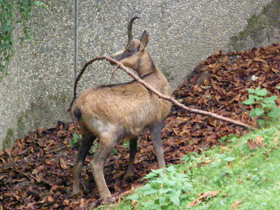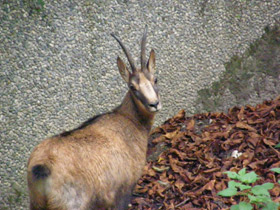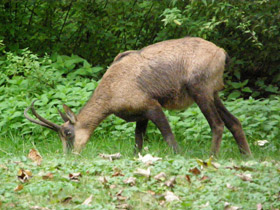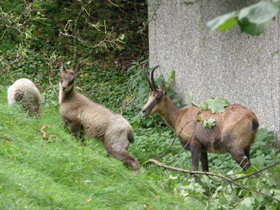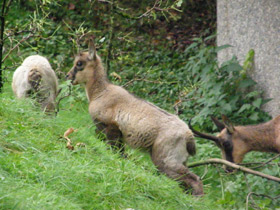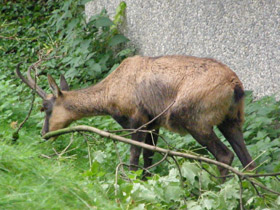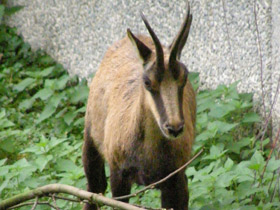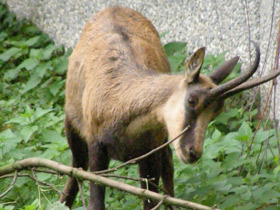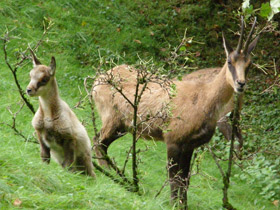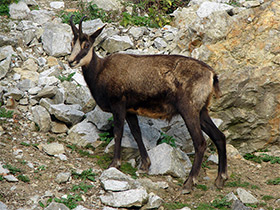The Pyrenean chamois Rupicapra rupicapra pyrenaica
Pyrenean chamois видео
Genus name of this chamois originates from Latin words rupes (rock, stone) and сарrа (goat) though some zoologists tend to relate this apparently "primitive" goat to the genus Rupicarpini that includes relict ancestors of true goats. This genus is also represented by the serows, Asian gorals, and North American Rocky Mountain goats.
The Pyrenean chamois is quite a delicate animal with thin neck, small head, strong legs and very short tail. It has long, pointed ears, large, prominent eyes, and big scent glands found behind the horns. The short (7 to 10 cm), smooth black horns of both males and females rise in a vertical fashion, and then bend backwards sharply to form hooks. The hooves are quite large but narrow; they are paddled and have sharp and hard front edges which allow the animals griping and keeping their footing on slippery rocks. The Pyrenean chamois is relatively large: it stands 70-80 cm at the shoulder, and reaches 125-135 cm in length; the weight of the males ranges between 30 and 50 kg, with females weighing 25 to 42 kg. The Pyrenean chamois is found in the mountains of the north-western Spain, the Pyrenees, and the Apennines of central Italy. The range of this subspecies became fragmented and now consists of many isolated areas. The Pyrenean chamoises reside in steep rocky slopes in both alpine and forest belts, and can be found at the elevations of 100 to up to 3,500-4,500 meter above sea level. In summer, they forage on the high alpine mountain sides and in the winter, they move lower down to the higher zones of the forests. In summer, the Pyrenean chamois’s coat is short and has light brown or reddish colour, while in winter its guard hair covering the dense undercoat becomes very dark and thick. Pyrenean chamoises have excellent senses of smell, hearing and vision; they can perfectly climb and jump, and when alarmed, speed to inaccessible places. The chamoises live in herds of 15 to 30 individuals; each heard consists of females, calves and young males. Older males are mostly solitary, except for the mating season. The chamois’s herds are the largest in autumn when their sizes may reach over hundred animals. During the summer months, the Pyrenean chamoises feed mainly on herbs and grasses, preferring flowers, buds and seed-vessels of umbelliferous and composite plants, and clovers, while in winter months they also eat green and dry cereals, lichens, thin tree branches, young shoots and buds of the willow, oak, rowan, blackberry, maple, and other plants; in summer times, the animals consume fallen acorns and chestnut fruits.
The rutting season in the Pyrenean chamois occurs from late October through November. During this period, the animals are very active; their scent glands enlarge and produce strong musky smell. The males make open-mouthed grunts and sometimes fight, trying to drive younger males from maternal herds. Two to six females gather around the winner, establishing a harem herd. Females have a gestation period of 160 to 170 days and beginning from the middle of May a single young calf is born in a shelter (twins are born more rarely). The calves are able to follow their mothers on their second day of life. They are not weaned until late summer, but start grazing on grass when they are one month old. Straight horns start growing in the young in August, and begin curving during the second year of life. By the age of 1.5 years, the young separate from their mothers. Young females reach sexual maturity in the second year but they usually start breeding only after they are three years old. The males are able to breed after they reach the age of 3 to 4 years.

















